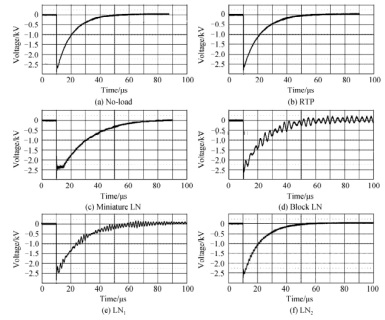Piezoelectric ringing
It is found that an oscillation occurs on the trailing edge of the voltage pulse once it was applied to a Pockels Cell (PC). The oscillation amplitude varies with PCs, as shown in the figure below. Under the same voltage, the oscillation amplitude of the voltage pulse applied to the block LN Pockels Cell (www.wisoptic.com) is much higher than that applied to the miniature LN PC. The voltage waveform applied to the RTP PC is smooth with no evident oscillation. The oscillation frequencies for the block LN PC and the miniature LN PC were measured to be 0.3 MHz and 1.64 MHz. By using the expression and parameters given in literature, the theoretical piezoelectric resonance frequency for the two PCs were calculated to be 0.27 MHz and 1.56 MHz, which demonstrates that the oscillation was caused by piezoelectric effects. Besides, it implied that the oscillation amplitude can be another indicator of piezoelectric ringing intensity.
 Waveform of voltages applied to different Pockels cells
Waveform of voltages applied to different Pockels cells
To investigate the dependence of the piezoelectric ringing on the dimensions of LN crystals, another two LN crystals with the dimensions of 3.8 mm × 9 mm × 19 mm and 2.3 mm × 2.6 mm × 9.4 mm were employed, they are labeled as LN1 and LN2. The voltage waveform applied to these two LN crystals are shown in figure above. Clearly, the oscillation amplitude of voltages pulses for these two crystals are higher than that for the miniature LN and lower than that for the block LN, and the voltage oscillation amplitude for LN1 is higher than that for LN2. The oscillation frequencies for LN1 and LN2 were measure to be 0.55 MHz and 0.9 MHz, which are consistent with the theoretical piezoelectric resonance frequency of 0.5 MHz and 0.83 MHz. Based on the above results, it is derived that the piezoelectric ringing decreases with the increasing of piezoelectric resonance frequency. The amplitude of the high frequency component of the voltage pulse decreases with the increasing of frequency. Thus as the piezoelectric resonance frequency increases, the amplitude of the voltage component that involves in piezoelectric resonance decreases, as a result, the piezoelectric ringing is weaker. Since the piezoelectric resonance frequency is determined by the dimensions of crystals, the piezoelectric ringing varied with the dimensions of LN crystals. The piezoelectric ringing in the miniature LN PC is weaker due to its larger piezoelectric resonance frequency.
The piezoelectric ringing in the miniaturized LN PC which was switched with the pulse-off EO driver is also negligible, as shown in figure below. Besides, there was no discernable change in performances when the repetition rate varied from 1 Hz to 15 Hz.
Piezoelectric ringing in miniaturized LN Pockels cell switched with a pulse-off EO driver
Post time: Jun-14-2022

